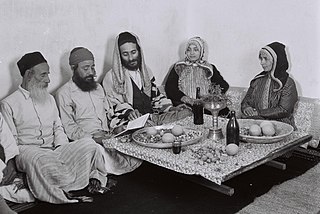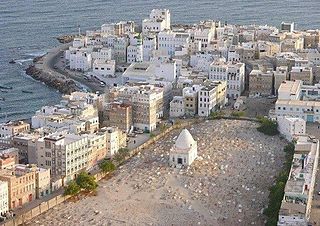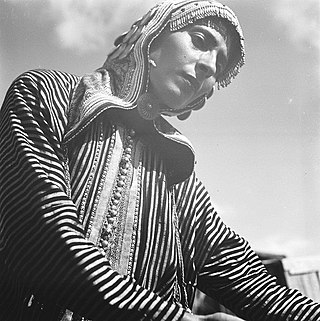In the 20th century, approximately 900,000 Jews migrated, fled, or were expelled from Muslim-majority countries throughout Africa and Asia. Primarily a consequence of the Israeli Declaration of Independence, the mass movement mainly transpired from 1948 to the early 1970s, with one final exodus of Iranian Jews occurring shortly after the Islamic Revolution in 1979–1980. An estimated 650,000 (72%) of these Jews resettled in Israel.

Yemenite Jews, also known as Yemeni Jews or Teimanim, are those Jews who live, or once lived, in Yemen, and their descendants maintaining their customs. Between June 1949 and September 1950, the overwhelming majority of the country's Jewish population immigrated to Israel in Operation Magic Carpet. After several waves of persecution, the vast majority of Yemenite Jews now live in Israel, while smaller communities live in the United States and elsewhere. As of 2022, only one Jew remained in Yemen.
In Judaism, Nusach (Hebrew: נוסח, romanized: nusaḥ, Modern Hebrew pronunciation nusakh, plural refers to the exact text of a prayer service; sometimes the English word "rite" is used to refer to the same thing. Nusakh means "formulate" or "wording".

Operation Magic Carpet is a widely known nickname for Operation On Wings of Eagles, an operation between June 1949 and September 1950 that brought 49,000 Yemenite Jews to the new state of Israel. During its course, the overwhelming majority of Yemenite Jews – some 47,000 from Yemen, 1,500 from Aden, as well as 500 from Djibouti and Eritrea and some 2,000 Jews from Saudi Arabia – were airlifted to Israel. British and American transport planes made some 380 flights from Aden.
The First Aliyah, also known as the agriculture Aliyah, was a major wave of Jewish immigration (aliyah) to Ottoman Syria between 1881 and 1903. Jews who migrated in this wave came mostly from Eastern Europe and from Yemen, stimulated by pogroms and violence against the Jews. An estimated 25,000 Jews immigrated. Many of the European Jewish immigrants during the late 19th-early 20th century period gave up after a few months and went back to their country of origin, often suffering from hunger and disease.

Jews in Eritrea can trace their history back to the late 19th century arrival of Yemenite Jews.
The B'nai Moshe, also known as Inca Jews, are a small group of several hundred converts to Judaism originally from the city of Trujillo, Peru, to the north of the capital city Lima. Judaism moved to the south into Arequipa and to other populated cities like Piura.

Adeni Jews, or Adenite Jews are the historical Jewish community which resided in the port city of Aden. Adenite culture became distinct from other Yemenite Jewish culture due to British control of the city and Indian-Iraqi influence as well as recent arrivals from Persia and Egypt. Although they were separated, Adeni Jews depended on the greater Yemenite community for spiritual guidance, receiving their authorizations from Yemeni rabbis. Virtually the entire population emigrated from Aden between June 1947 and September 1967. As of 2004, there were 6,000 Adenites in Israel, and 1,500 in London.

The history of the Jews in Hadramaut stretches back to ancient times. The Hadhrami Jews were a subset of the Yemeni Jews.

The Habbani Jews are a culturally distinct Jewish population group from the Habban region in eastern Yemen, a subset of the larger ethnic group of Yemenite Jews. The city of Habban had a Jewish community of 450 in 1947, which was considered to possibly be the remains of a larger community which lived independently in the region before its decline in the 6th century. The Jewish community of Habban disappeared from the map of the Hadramaut, in southeast Yemen, with the emigration of all of its members to Israel in the 1950s.

The history of the Jews in the territory of modern Saudi Arabia begins in Biblical times, at least as early as Solomon's Temple.

The history of the Jews in the Arabian Peninsula dates back to Biblical times. The Arabian Peninsula is defined as including the present-day countries of Bahrain, Kuwait, Oman, Qatar, Saudi Arabia, United Arab Emirates and Yemen politically and parts of Iraq and Jordan geographically.

Yemen is an Islamic society. Nearly all Yemenis are Muslims, with approximately 55% belonging to the Shia Islam and approximately 44% belonging to the Sunni Islam. Amongst the native population, there were approximately 1,000 Christians, and 6 remaining Jews in 2016. However, Pew-Templeton estimates the number of Christians to be as high as 40,000, though most do not publicly identify as such, due to fears of religious persecution. According to WIN/Gallup International polls, Yemen has the most religious population among Arab countries and it is one of the most religious populations world-wide.

Yemeni diaspora refers to Yemeni migrants and their descendants who, whether by choice or coercion, emigrated from Yemen and now reside in other countries.

The Yemenite Children Affair refers to the disappearance of mainly Yemenite Jewish babies and toddlers of immigrants to the newly founded state of Israel from 1948 to 1954. The number of affected ranges from 1,000 to 5,000.
Lebanese Jewish Migration to Israel included thousands of Jews, who moved to Israel, similar to how 1948 witnessed the emigration of hundreds of thousands of Jews from Arab countries. Yet, "unlike Jewish communities in many other Arab states, the Jewish communities in Lebanon grew after 1948 and it was not until the end of the civil war of 1975 that the community started to emigrate." This "Lebanese difference" derives from two components: more positive Lebanese relationships with European authorities during the French Mandate than experienced by other Arab states, leading to a more pluralistic outlook in Lebanon than its neighbors; some elements in the Maronite Christian community who were tolerant of Zionism.
Moroccan Jews in Israel are immigrants and descendants of the immigrants of the Moroccan Jewish communities who now reside within the state of Israel. The 2019 Israeli census counts 472,800 Jews born in Morocco or with a Moroccan-born father, although according to the World Federation of Moroccan Jewry, nearly one million Israeli Jews are Moroccan or of Moroccan descent, making them the second-largest community in the country.

Yemenite Jews in Israel are immigrants and descendants of the immigrants of the Yemenite Jewish communities, who now reside within the state of Israel. They number around 400,000 in the wider definition. Between June 1949 and September 1950, the overwhelming majority of Yemen and Aden's Jewish population was transported to Israel in Operation Magic Carpet.
Amram Qorah was the last Chief Rabbi in Yemen, assuming this role in 1934, after the death of Rabbi Yihya al-Abyadh, Resh Methivta, and which role he held for approximately two years. He is the author of the book, Sa'arat Teman, published post-mortem by the author's son, a book that documents the history of the Jews of Yemen and their culture for a little over 250 years, from the Mawza exile to the mass-immigration of Yemenite Jews to Israel in the mid-20th century.
The history of Jews in Somalia refers to the historical presence of Jewish communities in the Horn of Africa country of Somalia.














